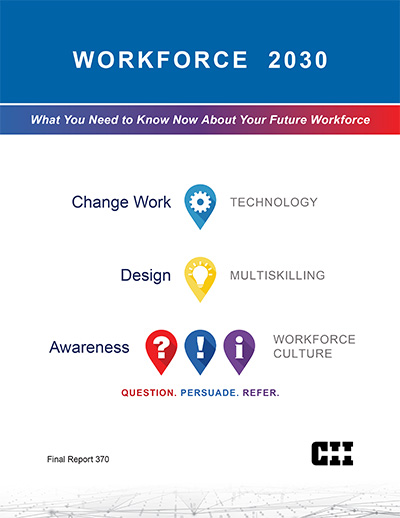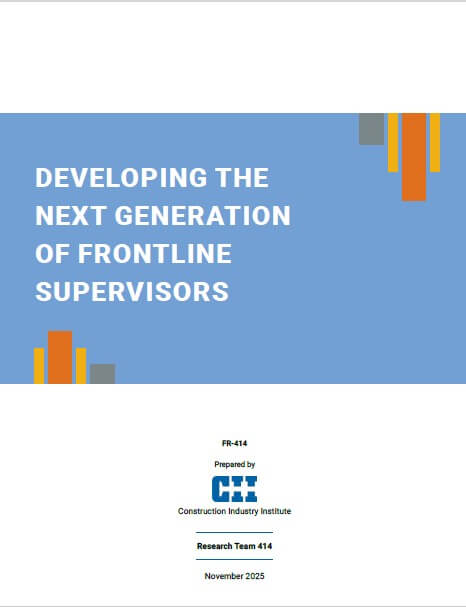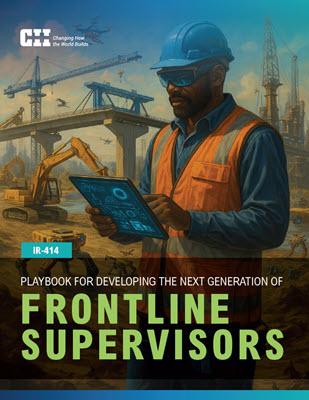
Workforce 2030: What You Need to Know Now About Your Future Workforce
As it looks forward to 2030, the U.S construction industry stands at a crossroads. The looming age cliff is about to present its most serious challenges yet, coinciding with a shortage in qualified skilled professionals. Construction technologies are being developed faster than they can be implemented, so the industry has yet to realize their full potential. In this context, Research Team 370 (RT-370) aimed to develop a roadmap to help companies respond to changes in technologies and the craft workforce over the next decade. Whenever sufficient data existed to support an evidence-based forecast, the team also offered its predictions for 2030.
For this analysis, the research team used 10 different data sources, including a craft survey of more than 2,700 craft professionals located across the U.S. The report team arrived at the following key findings:
- Despite the significant investment in technology made over the last decade, the impact of technology on project performance has been minimal. For instance, technology has not increased the amount of time that craft supervisors spend at the workface to the optimal level (60%) identified by RT-330, Improving Frontline Supervision in Industrial Construction.
To help the workforce of 2030 integrate technology better, the industry should focus its efforts to develop and implement technology on the human-technology interface. This emphasis should help the industry fully realize performance gains across the business process.
- The availability of multiskilling among the craft workforce increased over the last 15 years, and this trend should continue into 2030. This increase in multiskilling has been driven organically by worker preferences for remaining in one geographic location, rather than due to any corporate strategy that emphasized multiskilling. At the same time, spousal employment within the industry has grown to above 80%. Together, these factors point to reduced mobility among the craft workforce – a trend that is likely to intensify in coming years.
- Compared to all other industries, construction workers reported significantly higher incidents of being the subject of derogatory comments in their work environment. This was particularly true among female employees, who reported more negative perceptions of level of respect, productivity, professional treatment, and derogatory comments than their male colleagues mentioned.
Mental health issues present an increasing challenge to the industry, with the suicide rate in construction being significantly higher than in the general population. Each year, the industry loses four to five times more workers to suicide than to jobsite fatalities.
The construction industry is aging rapidly. The average age of the workforce is likely to exceed 46. The industry should be actively recruiting new workers, including females, and aim to retain its workforce by investing in improvements to workforce culture and mental health issues.
Given the challenges presented in this analysis. RT-370 offers the following recommendations to the industry:
- Leverage technologies to change work processes and train the workforce to implement these technologies to tap its full potential.
- Rethink the way the industry designs projects to take advantage of the increasingly multiskilled, less mobile workforce.
- Keep project execution requirements well within the skill framework of the available workforce pool. For example, the modularization of some components might allow for more efficient assembly, given the skills of the available workforce.
- Invest in recruiting and training construction workers from nontraditional demographics; particularly females, who currently make up only about 5% of the workforce.
- Actively work to destigmatize mental health issues and consistently promote a positive workplace environment. These actions would improve the reputation of the industry and could potentially help it to attract a younger workforce in the face of the impending age cliff.
Despite significant investment in technology over the last decade, the impact of technology on project performance has been minimal. For example, technology has not been successful in increasing the amount of time craft supervisors actually spend at the workface (37%) to the optimal level identified by RT-330 (60%).
Technology development and implementation should focus on the human-technology interface to fully realize performance gains across the business process (FR-370, p. 15).
The rate of multi-skills among the craft workforce increased over the last 15 years, and this trend should continue into 2030. This increase in multiskilling has been driven organically by worker preferences for remaining in one geographic location, rather than due to a corporate strategy to emphasize multiskilling. Additionally, spousal employment within the industry is above 80%.
Together, these factors point to reduced mobility among the craft workforce – a trend that is likely to intensify in coming years (FR-370, p. 23):
The construction industry continues to struggle with workforce culture.
Compared to all other industries, construction workers report significantly higher incidents of derogatory comments in their work environment. This is particularly true among female employees, who reported more negative perceptions of level of respect, productivity, professional treatment, and derogatory comments than their male colleagues.
Mental health issues are also an increasing challenge within the industry, with the suicide rate in construction being significantly higher than in the general population. Each year the industry loses four to five times more workers to suicide than to jobsite fatalities.
These challenges will make it increasingly difficult to attract young people to work in the industry (FR-370, p. 52).
RT-370 (FR-370, in press).



